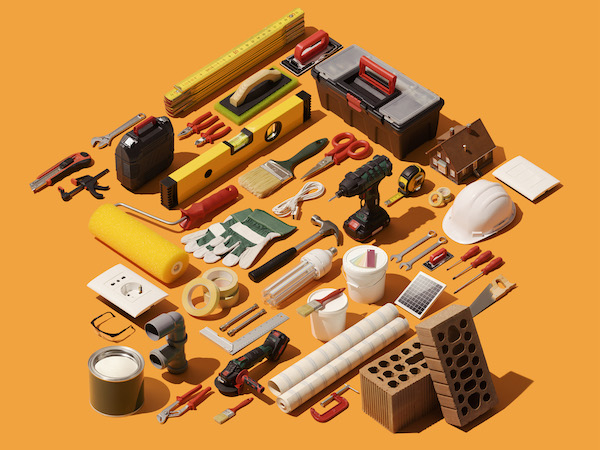Browse their websites to find out how long they’ve been in business, the areas where they’ve worked, and to see pictures of their projects. Then compile a list of questions to ask when you interview them. For example, find out if they are fully insured, ask for an estimated timeline and project cost, find out who will handle the permits for the job, and ask for references.
Next, take the time to review what current real estate research shows. Each year, surveys are conducted by various real estate organizations revealing the average return on investment (ROI) of popular home renovations. Contractors nationwide are canvassed to find out how much these upgrades cost to complete. This data is compared with how much real estate agents estimated these features would boost a home’s market price. This year’s answers may surprise you. Rather than make you pour over the research, we’ve done the work for you.
The results overwhelmingly show that if you’re going to spend money, do it where everyone will notice—on the front of your house. Any real estate professional will tell you that curb appeal is key to selling a home, and the numbers from this year’s reports prove it. Curb appeal projects freshen and update a home’s look, helping to increase its value and maybe even bring a faster sale.
The top three
The top three projects, in terms of cost recouped, are garage door replacement, manufactured stone veneer installation, and entry door replacement. Each of these projects boasts a rate of over 90 percent in terms of cost recoup, and these are the least costly to undertake, making curb appeal projects an all-around payoff. The neighborhood and homeowner benefit from an improved aesthetic, and the home itself increases in value, all while recouping almost all the initial investment.
The renovation offering the best return is a new garage door, which is low-cost on the front end but offers 98 percent return on investment when factored into the resale value of the home. The garage door sets the visual tone for your entire home. Not only will a run-down or dented garage door detract from your home’s appeal, but it will plant questions in the minds of potential buyers as to how well you’ve maintained the rest of your property.
Second is installing manufactured stone veneer, returning 97 percent of its initial cost in resale. New siding is a great way to freshen curb appeal. While any type of siding offers an updated look, masonry veneer will give you the best bang for your buck. Choose from dozens of styles of either brick or stone veneer, and have it professionally installed for the best appearance and resale value.
Front door replacement, especially steel, rounds out the top three. If your home’s shabby, worn entry door is visually unappealing, put a new steel entry door at the top of your remodeling list. It will liven up your home’s facade, and you’ll recoup a whopping 90 percent of your investment when you sell your house. Solid wood entry doors are beautiful, but a steel door offers the most security and the best ROI.
Other projects that add ROI
Other projects that will boost your home’s curb appeal are also worthy of consideration. When it’s time for an appraisal, a new roof will give you a 69 percent return on dollars spent (the average cost is $21,000) when the old shingles are replaced with new asphalt shingles (with a 25-year warranty). A shabby roof will deter potential buyers and discourage a mortgage company from lending those potential buyers money, so definitely replace that old roof if you plan to sell your home soon.
Replacing outdated, drafty double-hung windows is another upgrade that will increase your home’s curb appeal and energy efficiency. Today’s windows offer double or triple panes, low-e coatings, argon gas and easy-to-open casements. These projects have a cost recoup of 74.3 percent (vinyl) and 69.5 percent (wood), and they both have an average cost of under $20,000. New, energy-efficient windows also provide savings on utility costs.
If it is time to go ahead with the bigger budget remodels, the following information will help you to prioritize.
Many Americans are choosing to age in place, which means that the demand for accessible homes is rising.
These upgrades include wider doorways and hallways, lever-style doorknobs and flush or recessed thresholds. They can improve the quality of life for your family member and realize a 68 percent return on your investment.
In many cases, buyers’ “must have” lists now include upgraded outdoor spaces. If a new deck is also something you’ve been dreaming about, consider that a well-designed deck is now a top selling point. A composite deck will give you a 65-70 percent return on your money, while cedar, redwood or other wood decks are netting an 83 percent ROI.
Adding attic insulation is a project that will consistently net a homeowner a good return. The biggest loss of heat literally goes through the roof, so upping your insulation will boost your energy savings as well as your home’s value. The average cost to insulate an attic with fiberglass insulation is approximately $1,300, but the project increases resale value as much as $1,400, which means that you could recover up to 105 percent of the cost when you sell.
More considerations
Elaborate master suites are a major selling point in many of today’s new homes. A master suite addition is a pricey project, running $100,000 to $250,000 or more, but it could net from 65 percent to 80 percent ROI. On-trend master suite amenities are separate bathing and changing areas, his-and-her walk-in closets, and smart-home functionality.
If your master bath is lackluster, then consider a makeover. Start by replacing that worn-out tub and adding a tile surround. Small-scale upgrades such as luxury vinyl flooring or ceramic tile and a new sink and vanity are not only affordable, they’ll give you a full 100 percent return on your investment. To finish off, choose inexpensive to mid-range fixtures because high-end fixtures don’t pay off.
The kitchen is another expensive room to fully remodel, but a minor kitchen renovation offers an 80 percent ROI. A minor renovation can mean replacing cabinet doors and drawer fronts and perhaps refacing the existing cabinet base. Adding new countertops and a new sink will make a more dramatic statement, but even just adding new hardware can make a difference in how your kitchen looks and feels. By comparison, a full remodel (complete tear-out and replacement), will net only a 65 percent return.
Converting the attic into a spare bedroom (or more) can return as much as 93 percent of the project’s cost. Opting to convert that space into a new bedroom or two—plus an extra bathroom, if possible—will give you a greater ROI than creating a game room, kid’s den, or loft. Homes are listed in the real estate market by the number of above-grade bedrooms, so adding two bedrooms in the attic of a three-bedroom home boosts your classification to a five-bedroom, which in turn, will raise the home’s value and increase its marketability.
When you’re ready to sell—be it next month or next year—rest assured that making these improvements can add tens of thousands of dollars to your resale value, which is a great incentive to commence on your home improvement project. Still not sure where to start? Remember this hard and fast rule of renovation: in most cases it’s better to replace or repair than add or remodel. So, go ahead and fix that old siding or replace that shoddy roof before you add a master suite or completely overhaul the kitchen.



